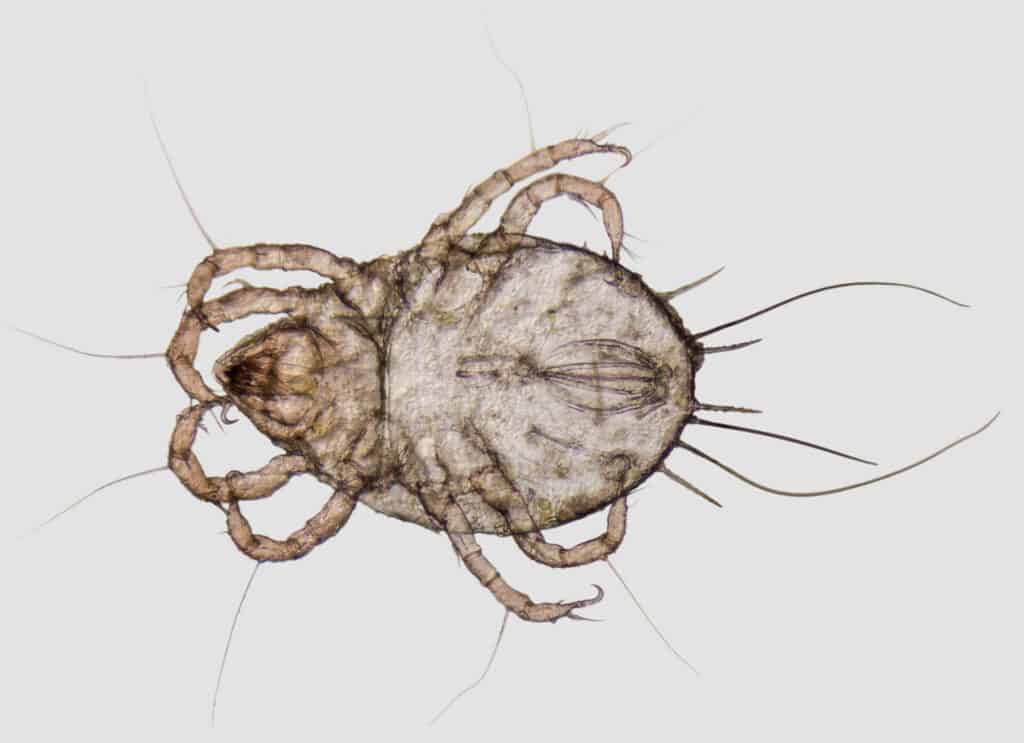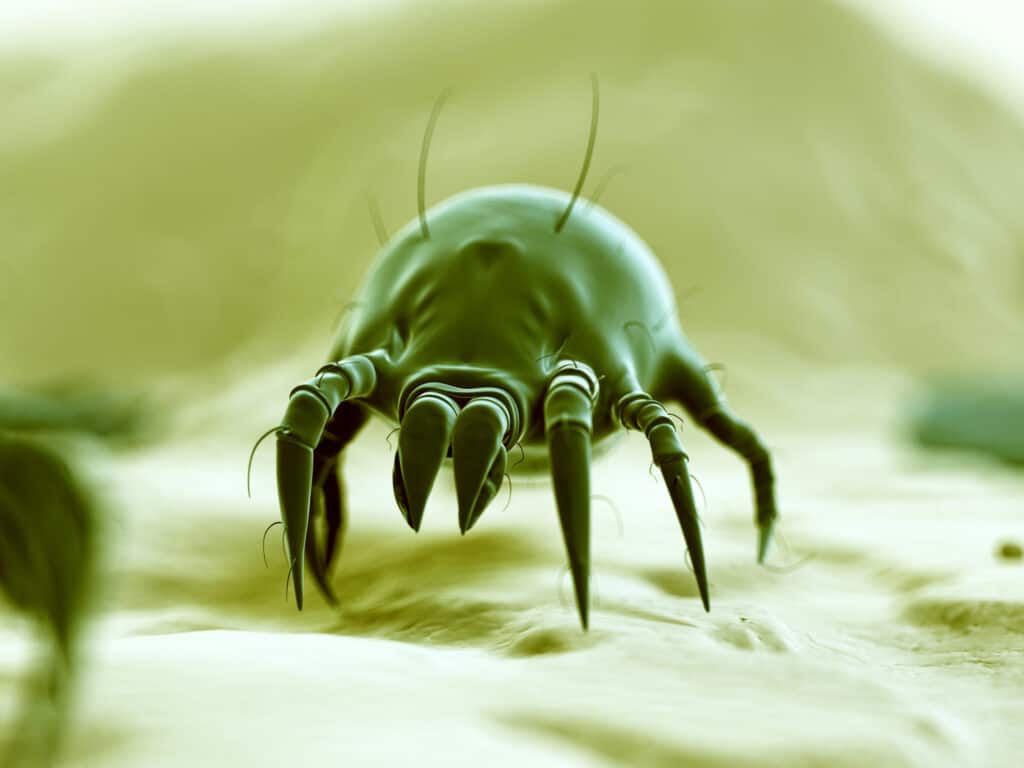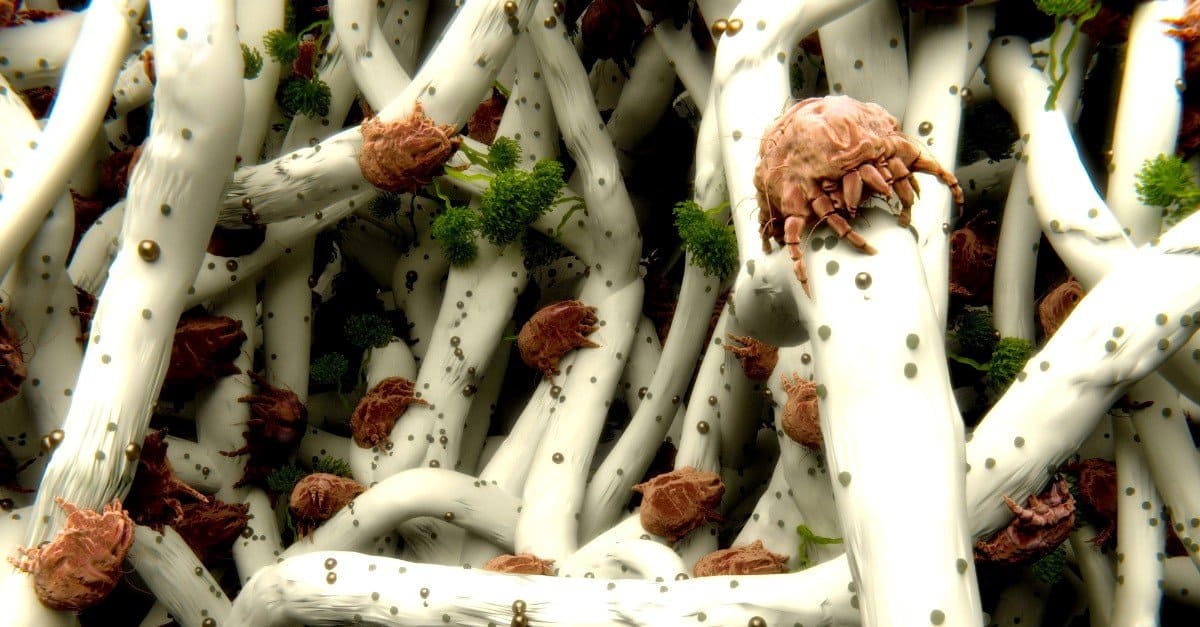Dust mites are about 0.01 inches long. As such, we cannot see them with the naked eye. However, given that they are usually called house dust mites, it is clear that almost every home on Earth is probably filled to the brim with them.
On top of that, just like any other living creature, they must eat something to stay alive. The question is, what exactly do they eat?
This is what we’re going to tackle in the following lines – namely, the diet of a creature that can barely be seen but that is around you all day long!
What Are Dust Mites?

Dust mites are
acariformmites and include several species of the Pyroglyphidae family.
©iStock.com/prill
Dust mites, usually referred to as house dust mites, are acariform mites and include several species of the Pyroglyphidae family. There are about 23 known species of dust mites. These creatures are found mainly in dust and are the main culprits when it comes to the reasons behind allergies.
A dust mite is about 0.01 inches long and releases fecal pellets of about 0.0004 – 0.002 inches long. One can barely see a dust mite with the naked eye; no wonder no one can see their fecal pellets! Dust mites can live for up to 100 days. During this time, the creatures produce over 2,000 fecal pellets, indicating that they eat a lot.
In terms of appearance, dust mites have translucent bodies and feature a striated cuticle. Naturally, you won’t be able to notice any of these.
What Do Dust Mites Eat?

Dust mites eat skin flakes and mold.
©iStock.com/selvanegra
Dust mites eat skin flakes and mold. As they live in households, the skin flakes they usually feast on come from animals and humans. There’s not much else to say regarding their diet – they usually eat anything they come across that’s small enough to be bitten.
In short, dust mites can eat anything that can be found in common house dust. This includes cotton fibers, wood, paper, a plethora of synthetic materials, cast-off skins of other mites or their own, and even their own fecal pellets.
It is worth mentioning that the survival of the dust mite doesn’t depend solely on its diet. Besides skin flakes and mold, dust mites require rather humid locations. This is the main reason why they’re commonly found in beds, where people breathe and sweat.
A List of Foods Dust Mites Eat
If you’re in a rush and want to know what dust mites eat, here’s the answer:
- Human skin flakes
- Mold
- Paper
- Wood
- Cotton fibers
- Pollen grains
- Feathers
- Spores
- Cast-off skins of other mites
- Their own fecal pellets.
What Eats Dust Mites?

Dust mite predators include silverfish and pseudoscorpions.
©iStock.com/tonaquatic
Since they’re almost microscopic creatures, dust mites could easily fall prey to many other species. However, since they primarily inhabit people’s houses, their predators will need to be in the same habitat to kill dust mites, which is unlikely.
Dust mites can be killed and eaten by other allergenic dust mites in the Cheyletiella genus that live on the skin of dogs, cats, and rabbits. Other dust mite predators include silverfish and pseudoscorpions.
How To Reduce the Dust Mite Population in Your Home?
Dust mites are a significant source of allergens and can make a simple seasonal allergy quite unbearable. Luckily, there are a couple of things that you can do to reduce your household’s dust mite population. The first step is to reduce your home’s humidity. Ideally, indoor humidity levels should be below 50% to reduce the dust mite population. You can buy a dehumidifier and a hygrometer to check the humidity levels.
Another method would be to use less padded furniture and items in your home. Instead, approach a minimalistic style and rely on furniture with smooth surfaces.
What Kills Dust Mites Instantly?
Dust mites are killed instantly by high temperatures and by vinegar acidity. As such, you can keep furniture dust-mite-free if you spray it with a vinegar concoction. Bedding, clothes, and other textile materials can be cleansed via a hot cycle wash at about 130 degrees Fahrenheit. Drying them at the same temperature is recommended.
How To Treat Allergies Caused by Dust Mites?

Dust mites are among the most common cause of allergies.
©iStock.com/SciePro
Dust mites are known as the most common cause of allergies, mainly from house dust. Nowadays, there are plenty of ways to treat such allergies. You can rely on inhaled steroids and antihistamines as safe ways to escape allergies. If not, you can try immunotherapy with the help of tablets and shots designed to combat allergies.
It is worth mentioning that not everybody is allergic to dust mites. As such, before starting the treatment against dust mite-caused allergies, it is recommended to see your doctor to confirm that you are indeed allergic to dust mites.
At the same time, while you might be allergic to dust mites, they don’t always trigger allergies. In this respect, you can easily avoid following medical treatment if you follow some of the aspects below:
- While vacuuming, wear a protective mask (they’re quite common and easy to find nowadays);
- After vacuuming, do not enter the vacuumed area for about 20 minutes – until the dust mites, dust, and other allergens are fully settled;
- When dusting, never rely on a dry cloth, as it raises allergens in the air. Use a damp rag instead;
- Removing curtains (made of fabric) might be a good way to escape allergies during summer;
- Even though there is a downside, you can avoid allergies by relying on synthetic bedding materials rather than feathered or wool ones;
- You can buy allergen-impermeable or dust-proof covers for your pillows and mattress for an extra layer of protection.
Up Next:
Thank you for reading! Have some feedback for us? Contact the AZ Animals editorial team.








